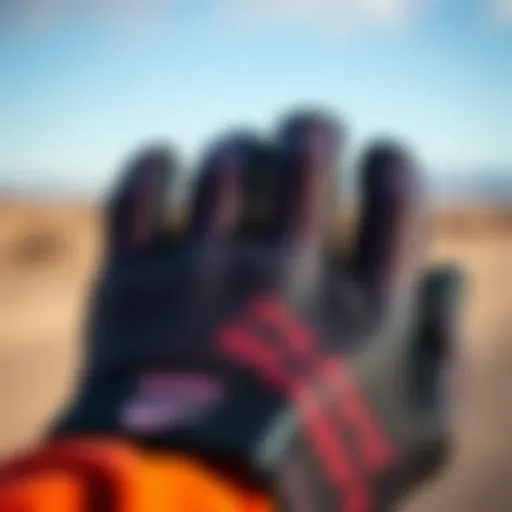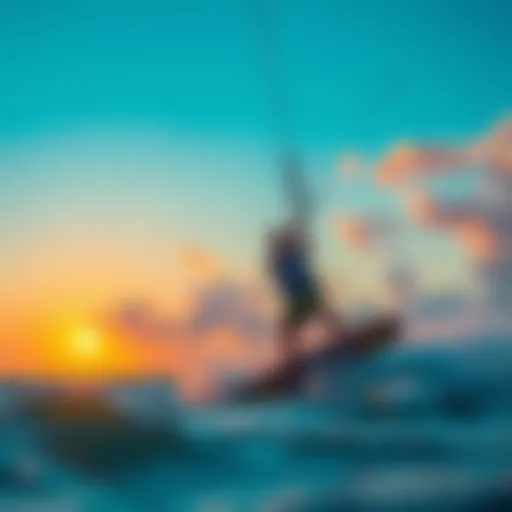Kiteboarding in the Turks and Caicos: An In-Depth Guide
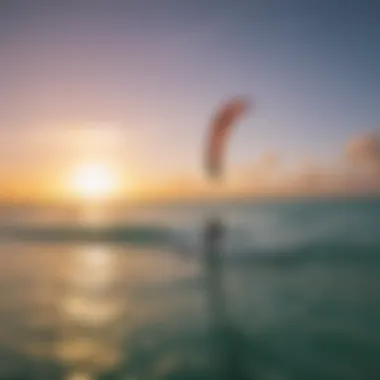

Intro
Kiteboarding has surged in popularity over recent years, drawing thrill-seekers and beach lovers alike to destinations that offer perfect winds and stunning waters. One such place that stands out is the Turks and Caicos Islands. Comprising a string of islands and cays, this majestic location blends vibrant marine life with extraordinary natural beauty, making it a prime kiteboarding hotspot.
As we dive into the nitty-gritty of kiteboarding here, it's essential to know that the conditions widely vary, offering something for everyone. Whether you're a rookie still finding your footing or an expert looking to twist and flip in the most picturesque settings, the Turks and Caicos have your back. With clear turquoise waters, consistent winds, and a commitment to preserving its natural allure, this destination promises an unforgettable experience.
We'll explore the essential gear you need, the skills required to ride the waves like a pro, and the local culture that makes the Turks and Caicos a special place for both kiteboarders and casual beachgoers. Let’s take a closer look at the gear that will ensure your kiteboarding adventure is both safe and enjoyable.
Gear Insights
When it comes to kiteboarding, having the right gear isn't just a luxury—it's a necessity. Let’s break down the key components that will enhance your time on the water, ensuring you have both fun and safety.
Latest Gear Reviews
The market is overflowing with options for kiteboarding gear, each claiming to be the best. Recent innovations include lightweight kites with superior pull, making them easier to control. Brands like Duotone and Naish have released models that cater to various skill levels while maintaining high durability against the elements.
- Duotone Rebel 2023: Known for its versatility, this kite performs exceptionally well in various wind conditions.
- Naish Slash: Perfect for wave riding, its responsive handling and powerful boosts appeal to more experienced kiteboarders.
Additionally, consider performance-focused boards such as Slingshot Phantasm, which combine speed and responsiveness, opening up opportunities for advanced tricks that make heads turn.
Essential Gear for Beginners
If you’re just starting out, finding the right equipment can be a bit overwhelming. Here's a shortlist of basics you should consider:
- Kite: Look for a user-friendly model with a larger surface area like the Liquid Force Easy, which provides stability and ease during learning stages.
- Board: A wider board offers better floatation. The North Aura board is a solid choice, giving newcomers the buoyancy needed.
- Harness: Comfort is key here. Opt for a comfortable waist harness like the Ion Radar to ensure it fits well.
- Safety gear: A helmet and impact vest are non-negotiables. Don’t skimp on these; they’ll protect you should you face any unexpected tumbles in the water.
Keeping a keen eye on equipment trends means you not only stay safe but also gain confidence while improving your skills. After all, feeling secure in what you’re riding can sometimes mean the difference between success and struggle.
"The right gear can shift the odds in your favor, making your learning curve smoother and more enjoyable."
As you prepare for your kiteboarding adventure, remember that gear can set the tone for your experience, so choose wisely!
Understanding Kiteboarding
Kiteboarding is not just about riding the waves; it’s an intricate blend of skill, equipment, and understanding of natural elements. Grasping the fundamentals of kiteboarding is crucial for anyone wanting to dive into this thrilling sport, especially in a stunning locale like the Turks and Caicos, where conditions can be downright perfect. This section will explore the sport’s backstory and its core elements, providing a backdrop to why kiteboarding attracts enthusiasts from all walks of life.
Historical Overview
The origins of kiteboarding date back to the late 1970s when innovative thinkers sought new ways to harness the power of the wind for propulsion. While variations exist, the most notable leap forward came in the 1980s when the introduction of inflatable kites revolutionized the sport. People have always been curious about flying; this passion led to experimentation with kites that could pull riders across water, combining aspects of surfing, windsurfing, and paragliding into one dynamic experience.
From its humble beginnings, kiteboarding has grown into a global phenomenon, with its popularity skyrocketing in the 1990s. The desire to gain speed, experience the thrill of the wind, and connect with nature fueled this surge. Today, various styles and disciplines have emerged, from freestyling to wave riding, reflecting the sport's adaptability and appeal.
Fundamentals of the Sport
Diving into the fundamentals of kiteboarding involves understanding a few key components: the equipment, techniques, and safety considerations. The kite itself is the heart of the operation. Kites come in diverse shapes and sizes, tailored for different conditions and skill levels. A proper kite selection can vastly improve the progression for new riders and give experienced kitesurfers the extra edge they seek.
- Types of Kites:
- Inflatable Kites: The most common type, perfect for beginners due to their stability and ease of use.
- C-Kites: These offer immediate power and speed but require advanced skills to control.
- Bow Kites: Provide a large wind range and are ideal for both beginners and advanced riders.
Alongside the kite, riders need a board suited to their style. Ideally, this could range from directional boards for wave riding to twin-tips for versatile tricks. The choice of board fundamentally affects the riding style and performance on the water.
Moreover, kiteboarding does not merely rely on equipment; understanding wind patterns and water conditions is paramount. Riders should learn how to read the wind direction, speed, and potential shifts, which can mean the difference between a fantastic session or a frustrating one.
In addition, mastering basic techniques, such as launching and landing the kite, body dragging, and controlled navigation, is essential for progressing in the sport. Keeping safety as the priority will ensure a long and enjoyable journey; thus, familiarizing oneself with emergency protocols enables riders to react decisively if things don’t go as planned.
"The wind is always changing, which makes kiteboarding an ever-evolving sport; adaptability is key to not only progress but also safety."
In sum, understanding kiteboarding stretches far beyond merely wanting to ride the waves. It’s about the knowledge, respect for the environment, and the thrill of mastering a sport that connects one with nature in an exhilarating dance across the sea. For those considering diving into this captivating world in the Turks and Caicos, knowing its history and fundamentals provides a strong foundation from which to launch.
The Turks and Caicos Landscape
The landscape of the Turks and Caicos plays a pivotal role in the kiteboarding experience. It’s not just about the act of riding; it’s about the entire environment that shapes each ride. From the striking turquoise waters to the powdery white sands, every element combines to create a playground for kiteboarders, making it paramount for both beginners and seasoned riders to understand.
Geographical Features
The Turks and Caicos Islands consist of around 40 islands and cays, though only a handful are inhabited. The main islands include Providenciales, North Caicos, Middle Caicos, and South Caicos. Providenciales, often simply called "Provo," is particularly significant for kiteboarding. It boasts expansive shorelines and sheltered lagoons that are ideal for all skill levels.
Key geographical features include:
- Flat waters: Many areas, such as Long Bay Beach, have flat, shallow waters, making them suitable for newcomers trying to gain confidence.
- Coral reefs: Surrounding cays offer breathtaking scenery while providing areas for more advanced riders who seek to challenge themselves amidst natural obstacles.
- Isolated beaches: Places like Sapodilla Bay give kiteboarders a sense of privacy, with fewer crowds disrupting the experience.
The specific topology allows kiteboarders to launch easily and practice tricks without fear of damaging their gear.
Climate and Wind Patterns
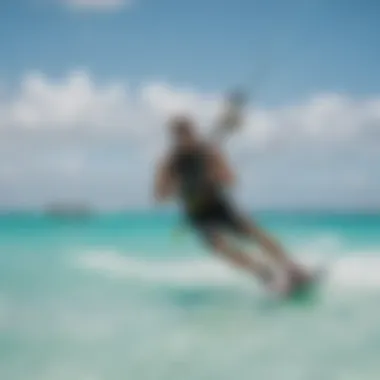

Understanding the climate and wind patterns is essential when planning a kiteboarding trip in the Turks and Caicos. The islands enjoy a tropical climate, which means warm temperatures year-round. However, it’s the wind conditions that truly set this paradise apart for kiteboarding.
- Ideal wind months: The optimal months for kiteboarding are from November to July, where consistent trade winds blow from the east. Wind speeds typically range from 15 to 25 knots, providing excellent conditions for those looking to harness the breeze while riding.
- Seasonal shifts: During the winter months, the winds tend to be more reliable, while summer can bring varying conditions. Nonetheless, summer still offers enough windy days to satisfy kiteboarders.
- Local knowledge matters: Local instructors and experienced kiteboarders often have their own weather indicators and preferences for specific spots, so it’s worth tapping into this wisdom upon arrival.
In summary, the Turks and Caicos landscape serves as a world-class setting for kiteboarding, with each geographical aspect and climatic nuance enhancing the overall experience.
Best Kiteboarding Locations in the Turks and Caicos
Kiteboarding is as much about location as it is about skill. The right spot can amplify the experience, providing the ideal conditions to ride the waves and catch the winds. In the Turks and Caicos, the azure waters meet a myriad of wind patterns across various beaches, making it a hotspot for kiteboarders of all levels. Here, we will explore three prime locations that stand out among the rest: Grace Bay, Long Bay Beach, and Sapodilla Bay. Each of these places brings its unique vibe and characteristics, tailored to different skills and preferences.
Grace Bay
Grace Bay is often heralded as one of the most beautiful beaches in the world. Its soft, powdery sands and crystal-clear waters offer a picturesque backdrop for kiteboarding. The winds here tend to be consistent, especially from December to April, making it a prime time for enthusiasts.
Unlike some of the other locations, Grace Bay is generally busy with beachgoers. This vibrant atmosphere might be well-suited for those looking to socialize or perhaps even grab a bite post-session. However, it also means being aware of the general public when embarking on your kiteboarding journey.
Key considerations for kiteboarding at Grace Bay include:
- Crowd levels: It might be wise to plan sessions during off-peak hours.
- Accessibility: Numerous rental shops and schools around the area can help newcomers or those needing gear.
- Safety: While the conditions are often favorable, always keep an eye out for swimmers and other beach activities.
All in all, a day spent kiteboarding at Grace Bay can feel like a vacation in itself, even when you’re pursuing an adrenaline fix on the water.
Long Bay Beach
In contrast to the hustle and bustle of Grace Bay, Long Bay Beach caters to kiteboarders looking for a quieter, more mellow experience. This stretch of white sand offers expansive space, allowing kiteboarders to spread out without the hassle of crowds.
One distinct feature is the shallow water that extends far from the shore, perfect for beginners and intermediates alike. The steady trade winds blow consistently here too, making it ideal for practicing techniques without the intimidating waves. With a more relaxed vibe, it attracts a different crowd, often consisting of families and those enjoying a peaceful day at the beach.
Benefits of kiteboarding at Long Bay Beach:
- Ideal for beginners: The shallowness allows for easy launches and landings.
- Less crowded: Ample space reduces the risk of collisions, which is reassuring for learners.
- Beautiful scenery: The breathtaking sunset views add an extra layer to the experience.
Sapodilla Bay
Sapodilla Bay represents a bit of a hidden gem. Located on the southern coast of Providenciales, this spot features flat waters that offer fantastic conditions for focused practice and riding. The bay is often less frequented by large crowds, making it a favorite for those serious about honing their skills or simply enjoying the tranquility of the surroundings.
Another major draw here is the seasonal conditions that provide gentle winds suitable for various skill levels, paired with a stunning landscape that feels almost untouched. Kiteboarding in this bay feels like stepping into a serene postcard moment, with the vibrant flora framing the backdrop.
With its unique offerings, consider these aspects when heading to Sapodilla Bay:
- Secluded vibes: Perfect for those who appreciate solitude while kiteboarding.
- Skill development: The calm waters create opportunities for advanced maneuvers and tricks.
- Natural beauty: A stunning locale makes the journey to and from the beach worthwhile.
Essential Gear for Kiteboarding
Kiteboarding is a sport that demands a specific set of gear for safety and enjoyment. Having the appropriate equipment is not just a matter of comfort; it's crucial for enhancing performance and ensuring a safe experience on the water. The right kite and board can make all the difference, especially in the varied conditions found in the Turks and Caicos. Let’s explore the essential gear you need to enjoy this exhilarating sport.
Types of Kites
Choosing the right type of kite is pivotal. Kites come in assorted shapes and sizes, each designed for different styles of riding and conditions. Generally, kites can be classified into three main types:
- Foil Kites: These kites have an inflatable head with a series of cells and are generally easy to launch and relaunch from the water. They can be a bit slower but are great for beginners due to their stability in lighter winds.
- Leading Edge Inflatable (LEI) Kites: Known for their versatility and performance, LEI kites have an inflatable leading edge and are suitable for various weather conditions. They allow for greater maneuverability, making them popular among intermediate and advanced riders.
- Hybrid Kites: A mix between foil kites and LEIs, hybrids offer a balance of stability and power. They are often favored for their adaptability across different wind and wave conditions.
These kites vary not only in design but in how they handle wind and manage lift. Riders might consider factors such as wind conditions and personal skill level when deciding on the type of kite to use.
Boards and Accessories
Once the kite is sorted, a suitable board is the next critical component. Kiteboards generally come in two primary formats: twin tips and directional boards.
- Twin Tip Boards: These have a symmetrical shape, allowing for easy riding in either direction. They are prevalent among freestyle riders because they offer great pop and speed.
- Directional Boards: Longer and typically used in surf conditions, these boards are ideal for riding waves, providing better control and stability when navigating through chop.
Accessories also play a significant role in kiteboarding gear. This includes:
- Harnesses: Essential for connecting the rider to the kite, a quality harness can make or break your ride. Choose between seat or waist harnesses based on your riding style and comfort.
- Footstraps or Boots: Depending on your board type, comfortable footstraps or closed-toe boots will help ensure better control and comfort while riding.
- Kite Lines: These are usually made from high-degree dyneema or spectra materials, offering high strength-to-weight ratios.
Selecting the proper board and accessories tailored for your specific riding style will enhance your experience significantly.
Safety Equipment
Safety should never be an afterthought in kiteboarding. The unpredictable nature of water sports means that having the right safety gear can be a lifesaver. Essential safety equipment includes:
- Impact Vests: These provide flotation and protection from waves when you wipe out. They're especially important in rougher waters.
- Helmets: While flying high can be tempting, a helmet offers vital protection against falls and collisions.
- Leashes: These devices keep your kite attached to your body in case of a mishap, preventing it from drifting away.
- Kite Safety Systems: Most modern kites are equipped with quick-release safety systems. Familiarize yourself with this feature to ensure you're ready in an emergency situation.
"Always prioritize safety. It’s not just about style, but survival in kiteboarding. Protect yourself, and you can enjoy the ride more!"
In summary, the right essential gear for kiteboarding makes all the difference. Investing in the best kites, boards, and safety equipment suited to your level can make kiteboarding in the Turks and Caicos a truly spectacular experience.
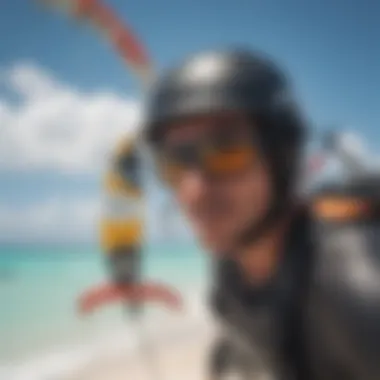

Techniques and Skills Development
Learning the ropes of kiteboarding is no small feat. It’s not just about flying a kite and riding a board over the shimmering waters; it demands a fusion of techniques, skills, and finesse. In the stunning environment of the Turks and Caicos, where the winds and waves beckon, mastering these skills can transform an amateur into a truly capable kiteboarder.
In this section, we’ll explore various techniques essential to kiteboarding progression and the benefits they yield, from beginner basics to more complex maneuvers.
Beginner Techniques
For anyone dipping their toes into the kiteboarding scene, starting with solid foundational techniques is crucial. Understanding the wind is typically the first stepping stone. Newbies should learn how to gauge wind strength and direction, as this knowledge lays the groundwork for safer practices.
Some key techniques include:
- Kite control: Practicing with a trainer kite on the beach helps beginners understand how to maneuver a kite effectively.
- Stance and balance: Getting comfortable on the board while maintaining a balanced stance aids in more stable rides. Practicing this on land first can be quite beneficial.
- Basic water starts: Initiating a water start involves positioning the kite at a specific angle and timing the pull with body movement. Beginners should practice this under supervision to prevent missteps.
"Master the wind and the water will be your playground."
These initial techniques create a strong base to build on. Prioritizing safety and proper guidance will ensure early mishaps are minimal, allowing you to progress confidently.
Intermediate Techniques
Once you've grasped the basic techniques, exploring intermediate maneuvers can elevate your skill set. At this stage, kiteboarders often begin practicing jumps and directional changes, which require a deeper understanding of kite mechanics and body positioning.
Important intermediate techniques include:
- Jumping: Learning the correct timing to edge against the water while pulling the kite up allows for jumps. Here, understanding the wind’s power is vital.
- Toeside riding: This technique enhances your agility on the board and boosts confidence when changing direction.
- Transitioning: Smoothly switching from riding heel-side to toeside helps improve versatility and control on the board, making it easier to handle different conditions.
Practicing in conditions suited for intermediate riders is essential. The Turks and Caicos provide a perfect backdrop, with flat waters and steady winds that make these maneuvers exciting yet manageable.
Advanced Techniques
While basic and intermediate skills set a strong foundation, advancing to expert-level techniques amplifies the thrill of the sport. Advanced kiteboarders often explore complex aerial maneuvers, tricks, and wave riding techniques that can significantly challenge one's balance and coordination.
Some advanced techniques encompass:
- Aerial tricks: Performing spins, flips, or rotations in the air requires not just physical skill but also a thorough understanding of kite aerodynamics.
- Jibe/wave riding: These techniques focus on riding with ocean waves, enhancing performance under different water conditions and providing a unique challenge.
- Kiteloops: This exhilarating maneuver requires pulling the kite back hard to loop it through the air, generating a rush unlike any other.
Engaging in peer learning or seeking advanced lessons from seasoned instructors can help one refine these skills. Having a supportive kiteboarding community in the Turks and Caicos makes it easier to exchange tips and techniques.
Safety Considerations
When it comes to kiteboarding, especially in a breathtaking environment like the Turks and Caicos, prioritizing safety is not just a precaution but an absolute necessity. This exhilarating sport, while rewarding, carries its own set of risks. Understanding these risks and adopting well-planned safety measures enables you to enjoy the sport without inviting trouble. It's about safeguarding yourself and ensuring that adventure doesn’t turn into misadventure.
Understanding Risks
Kiteboarding involves a unique blend of the forces of nature and human manipulation. Understanding the potential hazards involved is crucial. One major risk comes from the wind itself; strong or unpredictable gusts can lead to accidents. For instance, losing control of your kite due to sudden wind changes can cause a fall or even worse, a collision with objects on land or water.
Additionally, water conditions can also pose risks. Shallow reefs, unexpected currents, or rocky areas are hazards you might not see until it’s too late. This is why scouting the kiteboarding location and being aware of the environment is key. Beyond natural risks, there's also the risk of injury from improper technique or equipment failure. If your gear malfunctions, it can lead to serious accidents. Always inspect your equipment before hitting the water.
"Safety doesn't come from luck; it comes from preparation."
Weather Awareness
This region is known for its favorable kiteboarding climate, but staying informed about weather conditions is pivotal. Before heading out, checking weather forecasts can save you both hassle and danger. Pay attention to wind speeds and direction, potential storm patterns, and changes in tides. In the Turks and Caicos, the weather can shift quickly, catching you off guard if you aren’t prepared.
Kiteboarders should also familiarize themselves with the local weather patterns typical to the area. For instance, afternoons can bring increased wind speeds which may not be ideal for beginner kiteboarders. Having knowledge about the region can help in making informed choices and avoiding days that are too turbulent or risky for your skill level.
Emergency Protocols
Preparation for emergencies is just as critical as the fun and thrill of kiteboarding. Imagine you find yourself caught in a precarious situation on the water. Knowing how to react can mean the difference between a safe return and serious consequences. First, familiarizing yourself with basic rescue techniques such as signaling for help or executing a self-rescue maneuver is important. Having a buddy system in place, where you kiteboard with others, can provide essential support in case of an emergency.
In addition, understanding the nearest safe zones and having quick access to communication devices like a waterproof phone is advised. In the Turks and Caicos, mobile reception is generally good, but it’s smart to have a backup plan.
Utilizing local resources like kiteboarding schools or instructors can aid in understanding local risks and emergency measures specific to the area. Always ensure a solid plan is in place before you launch yourself into the water.
Local Culture and Community
When one envisions kiteboarding in the Turks and Caicos, it's easy to get lost in thoughts of turquoise waters and consistent winds. Yet, beyond the stunning landscapes lies a vibrant culture that enhances the kiteboarding experience significantly. Engaging with the local community not only enriches one's understanding of the sport but also fosters a sense of connection to the islands. Local instructors, events, and a shared passion for kiteboarding create a tapestry that weaves together adventure and cultural immersion.
Engagement with Local Instructors
Local instructors play a crucial role in the kiteboarding scene of the Turks and Caicos. Not only do they impart key skills and techniques, but they also introduce learners to the idiosyncrasies of the waters. Every area has its own quirks, and local knowledge is indispensable in ensuring a safe and enjoyable experience.
For example, an instructor from the islands can share insights about the best times to hit the water, local currents, and any hidden hazards. They also tailor lessons to fit individual skill levels, fostering a relaxed environment conducive to learning. This engagement with locals creates a mutual respect and understanding between visitors and the community that is often lacking in other tourist-oriented locations.
Kiteboarding Events


Kiteboarding events in the Turks and Caicos not only showcase athleticism but also celebrate the island's unique culture and sense of community. From small competitions to larger festivals, these gatherings are opportunities for enthusiasts to connect and share their love for the sport.
- Friendly Competitions
Smaller, informal competitions occur regularly across various beaches. These events help budding kiteboarders gauge their skills against peers, while seasoned riders are often on hand to give pointers. - Annual Kiteboarding Festivals
Larger festivals, like the Kiteboarding Championship held every year, attract kiteboarders from around the globe. Competitors exhibit their talents, while spectators enjoy a vibrant atmosphere filled with music, food, and cultural displays. - Community Workshops
These workshops often focus on environmental conservation, combining the love of the sport with a commitment to protecting the delicate ecosystems that make this area special. Participants learn about reducing environmental impact while kitesurfing and how the community can collectively preserve their surroundings.
The blending of local culture with sporting events creates a distinctive experience. Visitors leave not just with skills but with memories of interactions, stories, and shared joy in kiteboarding. As the locals say, "The wind may take you places, but community is what brings you home."
Engaging with the locals, whether through instruction or participation in events, transforms the kiteboarding journey into a communal experience, building lasting connections and a deeper appreciation for the beauty of the Turks and Caicos.
Travel Logistics and Accommodation
Planning a trip to kiteboard in the Turks and Caicos can be an adventure in itself. Understanding the travel logistics is crucial not just to make the journey smooth but to ensure you can fully enjoy the kiteboarding experience upon arrival. This section examines the various aspects of getting to this kiteboarding paradise and assesses the accommodation options that will keep you close to the action.
Reaching the Turks and Caicos
The Turks and Caicos is an archipelago that draws kiteboarders from across the globe. To reach this stunning destination, there are a few routes to consider. Most visitors typically arrive via the Providenciales International Airport, which is well-connected to major hubs like Miami, New York City, and Toronto. It's like a gateway to the magic of turquoise waters and gentle breezes.
Flights can vary significantly in price, depending on the season, so it pays to shop around a bit. Booking in advance can often lead to significant savings.
Travel Tips:
- Check for direct flights: If you’re coming from North America, there are several airlines offering direct flights.
- Visa Requirements: Most travelers from the U.S., Canada, and the U.K. do not require a visa. However, do verify if you’ve got everything sorted before you leave.
- Transportation: Upon arrival, renting a car or taking a taxi is generally the best way to navigate the islands. Some accommodations even offer shuttle services.
With planning in place for reaching the islands, the next step is to find the right place to stay.
Accommodation Options
When it comes to accommodation in the Turks and Caicos, there’s a broad spectrum to choose from, catering to various tastes and budgets. From luxurious beachfront resorts to cozy guesthouses, you'll find something that meets your needs.
- Resorts: Places like the Beaches Resorts or The Palms offer a complete package with amenities that include kiteboarding lessons on-site, making it easy for beginners and seasoned pros alike. Think of them as all-in-one havens for relaxation and adventure.
- Boutique Hotels: For those looking for something a little more intimate, boutique hotels often have unique touches and personalized service. Places like The Oasis at Grace Bay provide a fantastic atmosphere while keeping you in proximity to kiteboarding spots.
- Vacation Rentals: If you prefer a more home-like environment, renting a villa or apartment through platforms like Airbnb can be an excellent option. This way, you can indulge in the local lifestyle, perhaps even cooking your own meals.
Regardless of the type of accommodation you choose, ensure it’s within reasonable distance of prime kiteboarding locations. After all, who wants a long trek post-session?
"It's not just about the destination, it's about the journey and how comfortable you feel along the way."
In summary, travel logistics and accommodation play pivotal roles in a kiteboarding trip to the Turks and Caicos. Getting there can be straightforward with the right planning, and finding a comfortable place to stay ensures you are well-rested and ready to take on the waves. Once these aspects are settled, it’s time to shift your focus to the exciting waves and winds awaiting you in the shimmering waters!
Sustainable Kiteboarding Practices
When we dive into the realm of kiteboarding, it’s easy to get swept away by the thrill of speeding across the water, the wind in your hair, and the exhilarating rush of adrenaline. However, overshadowing this delight is a pressing concern: sustainability. In the Turks and Caicos, where nature's beauty is a significant draw for kiteboarders, adopting sustainable practices becomes not only beneficial but essential for preserving these idyllic surroundings.
Embracing sustainability isn’t just a fashionable trend; it’s about ensuring that future generations can enjoy kiteboarding in a pristine environment. Moreover, implementing eco-friendly measures can enhance the overall experience, making it richer and more fulfilling.
Environmental Considerations
Kiteboarding, as an outdoor sport, intertwines closely with nature. The simplicity of the kites and boards belies the environmental impact they can have if not managed responsibly. Here are some pivotal aspects to consider:
- Waste Management: It’s crucial for kiteboarders to dispose of waste properly. This includes avoiding littering beaches and ensuring that all your equipment is taken back with you.
- Wildlife Protection: The stunning landscapes of the Turks and Caicos are home to diverse wildlife. Respecting these creatures and their habitats while kiteboarding is vital. Make sure to maintain a distance from nesting areas or sensitive ecological zones.
- Eco-friendly Gear: Look out for kiteboarding brands that prioritize sustainability in their operations, such as using recycled materials for their gear. This can contribute to a lesser carbon footprint.
“Sustainability in adventure sports is not just a choice, it’s a way of ensuring that the beauty we enjoy today remains for tomorrow.”
By engaging in such practices, kiteboarders not only enjoy their sport but actively contribute to the preservation of their environment. It’s this symbiotic relationship between sport and nature that can make each session even more rewarding.
Community Impact
The ripple effect of kiteboarding in the Turks and Caicos goes well beyond individual experiences; it touches the community as well. Supporting local economies through responsible practices can yield benefits both for residents and visitors alike. Here are some factors to contemplate:
- Local Business Support: Frequenting local kiteboarding schools, shops, and rentals helps boost the economy. When tourists choose to engage with local services, it fosters a sustainable economic ecosystem in the area.
- Cultural Exchange: Engaging with local instructors not only enhances the learning experience but also fosters cultural exchange. Understanding local customs and values helps promote community pride and preservation.
- Community Projects: Many kiteboarding communities participate in beach clean-ups and environmental awareness initiatives. Getting involved in such projects can create a profound bond with the place you’re visiting while giving back in meaningful ways.
The essence of sustainability in kiteboarding goes hand in hand with community well-being. It’s about building a legacy where both nature and people flourish, ensuring that every leap from the board is a step towards a more sustainable future.
Future of Kiteboarding in the Turks and Caicos
The future of kiteboarding in the Turks and Caicos is a fascinating subject, one that captures the essence of what makes this sport both exhilarating and accessible. With the pristine beaches and consistent winds, the potential for growth in this area seems almost limitless. As kiteboarding gains popularity globally, the Turks and Caicos has an opportunity to position itself as a premier destination, drawing enthusiasts from around the globe. This calls for an exploration of the various developments and advancements that could foster a thriving kiteboarding ecosystem in this tropical paradise.
Potential Developments
Several factors indicate a promising future for kiteboarding in the Turks and Caicos. One significant aspect is the increase in tourism. With more travelers looking for adventurous experiences, kiteboarding stands out as an appealing option. Local boardsports businesses are also adapting to this growing interest by enhancing their services and offerings. This might include rental packages, guided tours, and professional lessons tailored to all skill levels.
Furthermore, community engagement is vital. As more locals recognize the economic benefits of kiteboarding, there's a push for collaborative events, tournaments, and festivals. Such gatherings not only promote the sport but also strengthen community ties, showcasing local talent and enhancing visibility on a global scale.
The importance of sustainability cannot be overlooked. With the rising awareness of environmental challenges, kiteboarding operations might begin adopting more eco-friendly practices. Initiatives could involve minimizing the use of plastics, preserving local marine habitats, and contributing to reef conservation efforts. The benefits are manifold—not only do these practices attract environmentally conscious individuals, but they also fortify the region’s ecosystem, ensuring kiteboarding persists as a favored pastime for generations to come.
Advancements in Equipment
Equipment innovation is another pillar supporting the future of kiteboarding. The shift towards lightweight, durable materials helps enhance performance, making it easier for riders to gain control and maneuver effectively. Brands are experimenting with new designs that improve aerodynamics, leading to smoother and faster rides. Not to mention, developments in safety gear, such as enhanced harnesses and quick-release systems, bolster confidence among newbies and seasoned riders alike.
Adoption of technology is reshaping the scene, too. Smart wearable devices could revolutionize training. Riders might use these gadgets to analyze their performance in real time, helping them understand their strengths and areas needing improvement. Community forums, such as those found on Reddit or Facebook, can foster knowledge sharing and innovation among enthusiasts.
"The true essence of kiteboarding lies not just in the thrill of riding but also in the camaraderie shared among those who dare to chase the wind."
In summary, the trajectory of kiteboarding in the Turks and Caicos looks bright. By leveraging tourism growth, enhancing local engagement, adopting sustainable practices, and embracing equipment advancements, the region can solidify its status as a kiteboarding haven. This not only benefits riders but also enriches the local culture and promotes environmental stewardship.



